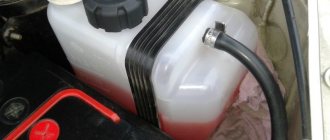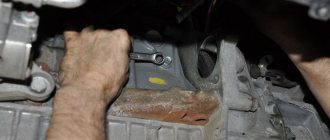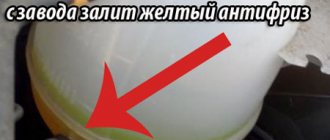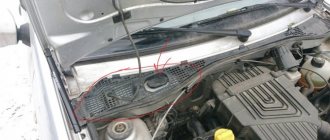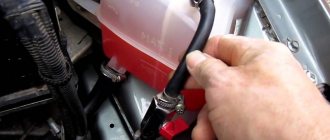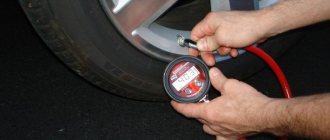Car : Lada Kalina. Asks : Anastasia. The essence of the question : half a tank of antifreeze goes in a week, where?
I was tired of adding antifreeze to the cooling system. Or rather antifreeze, pink, FELIX , which was still filled from the factory. Within a week it goes below the MIN . I go to work in the morning and from work in the evening. no more than 20 km . I can't figure out where he's going. The smoke from the car is white and normal.
Reasons for decreased fluid
There may be several reasons why the coolant may become smaller even in the absence of leaks.
- A drop in fluid level due to seasonality. This phenomenon is considered normal, because according to general physical laws, when winter or cold autumn sets in, the volume of liquid decreases. Accordingly, the driver sees a decrease in antifreeze in the system.
- The second reason for reducing the amount of antifreeze is due to the carelessness or inattention of the car owner. After adding fluid, many people do not screw the cap on the expansion tank tightly. Due to the access of air, the pressure increases, and the coolant oozes through a loosely closed neck. It is easiest to detect such a malfunction in winter, since when the engine is running, antifreeze becomes white smoke oozing from the radiator area. To fix the problem, just tighten the cap tightly on the expansion tank.
- The third and most unpleasant cause of fluid leakage is depressurization inside the cooling system. If such a malfunction occurs, the coolant enters the cylinders and is processed along with the fuel. The problem can be identified by the appearance of white smoke and a sweetish smell from the exhaust pipe. In addition, a white coating may appear on the oil level dipstick.
If there is a leak in the vehicle's cooling system, the antifreeze circulation is disrupted. The result may be liquid entering the cylinders through burnt or cracked areas in the cylinder head gasket . The occurrence of such a problem is fraught not only with a visual and very rapid decrease in the level of antifreeze in the expansion tank, but also with the fact that if there is a leak, the coolant can get into the oil, diluting it to a consistency unsuitable for further use of the vehicle. Also, the presence of cooling liquid in the cylinders can cause the formation of various types of deposits and carbon deposits, leading to a decrease in the overall performance of the power unit.
You can eliminate problems with coolant leaks either on your own or with the help of qualified specialists. However, it is very difficult to find a burnt or cracked place on the cylinder head gasket on your own. In this situation, it is better not to take risks and immediately go to a quality car service.
The situation when antifreeze leaves the expansion tank is familiar to many car enthusiasts. In some cases, the cause of the breakdown can be determined with the naked eye. A cracked tank, serious leaks under the bottom of the car will not leave it unnoticed. But a number of breakdowns are hardly possible to determine without qualified assistance. In such cases, the coolant gradually leaves the tank, the owner does not find any defects and simply tops it up.
Fixing leaks under the driver's feet — Lada Kalina Sedan, 1.6 l., 2006 on DRIVE2
Hi all. Some owners of viburnums have probably encountered such a problem as water in the cabin under the driver’s feet. I decided to share my method of solving this problem.
This problem happened to me after installing the bortovik. To splice the wire from the BC with the FLS wire, it was necessary to find a block behind the mounting block with the required wire. The problem was that the wires in the harness were tightly grouped and in order to splice the necessary ones, I had to slightly pull the harness towards myself. Apparently, after this manipulation, the rubber seal through which the harness passed into the cabin burst. The rubber band can also be torn when installing the alarm.
. After that, I began to notice that either after washing the car, or after rain, the carpet under the driver’s mat became like a sponge (if you pressed, water came out). It works like this: water flowing down the windshield exits through drainage holes in three places. One on the right under the cabin filter, the second in the middle, the third on the left. Under the hole on the left, in the wing, there is the same wiring harness through which water from the hole in a thin stream enters the cabin through a torn rubber seal.
This is approximately where the wiring harness and rubber seal are located.
You can check by pouring a little water from a bottle into the hole and lifting up the carpet and sound insulation on the driver's side, observing how a trickle of water oozes through the wires in the corner. After reading the Kalina Club forum, I found similar problems, which were sometimes eliminated by generously covering the sealing gum with sealant. This procedure helped, but not for long. I decided to act radically I took a hose along the diameter of the hole, 30 cm long, and inserted a cut neck from a bottle for transmission oil into it (it turned out like a funnel, but with a flat head).
I installed this device and again checked for leaks.
Water no longer leaked into the cabin. PS: There have been good rains recently, everything is dry under the rug
Natural causes
When a car owner discovers a leak and carefully checks the entire system for damage, the absence of major problems with the radiator, hoses, tubes and barrel may seem like a good sign. But this is not entirely true, because antifreeze is involved in many processes, and the integrity of the main elements may indicate more serious problems with the engine. But before you go to a service station, it is worth taking into account the natural factors of why antifreeze may decrease from the system:
ATTENTION! A completely simple way to reduce fuel consumption has been found! Don't believe me? An auto mechanic with 15 years of experience also didn’t believe it until he tried it. And now he saves 35,000 rubles a year on gasoline! Read more"
- Time factor. It is impossible to achieve perfect tightness of the system. In addition, temperature changes in different areas lead to the gradual evaporation of antifreeze. For each car model, depending on operating conditions, there are established consumption standards.
- Seasonal factor. Most complaints from owners about a sharp decrease in antifreeze levels come in the winter. Antifreeze consumption increases for understandable physical reasons. Negative temperatures cause the liquid to contract in volume, and the reverse process occurs when the engine is running. A decrease in level in such cases is normal and there should be no cause for concern.
It is important to understand that natural causes of low coolant levels result in very slow flow rates. If a car enthusiast in winter has to occasionally add a small amount of antifreeze to the keg, then there is nothing wrong with that.
Obvious damage
Antifreeze is designed to cool a car engine. A liquid with many additives is used in warm and cold seasons. Most compounds allow you to operate the machine at temperatures below - 60 degrees. A complete lack of coolant in the system will lead to rapid overheating of the engine, it will jam, and the car will fail. It is very expensive to overhaul the most expensive element in a car, so you need to carefully monitor the technical condition of all elements . The most common breakdowns that can lead to a rapid noticeable loss of antifreeze levels are:
Filling the cooling system
To deal with a problem, you need to know what it might be. To begin with, we note that antifreeze, which is the basis of the cooling system of any car, is a specific composition of chemical substances, thanks to which the engine does not overheat in hot weather, and the radiator does not freeze in cold weather.
Antifreeze boils at a much higher temperature than ordinary water. It usually has a boiling point of 110-130 degrees Celsius, depending on the type of additives in the composition. Some antifreeze compounds have a boiling point of up to 197 degrees.
Difficulties in diagnosis
Despite the fact that all such reasons are obvious, it is not always possible to independently determine where the antifreeze goes from the expansion tank. For example, very often damage to pipes remains invisible to the naked eye. In such cases, experienced car enthusiasts advise letting the engine cool completely, dry your hands thoroughly and carefully feel each connecting element. Microcracks will definitely make themselves felt , and coolant leaks will form on the hose.
Hidden leaks
Car owners often complain that antifreeze is running out, but the reasons cannot be determined, because all connecting tubes and hoses are in good condition. It is also not possible to detect leaks under the bottom, there is no characteristic smell in the cabin, but the coolant level has to be constantly replenished. In this case, this may mean that the reason lies in hidden leaks, which even experienced professional mechanics cannot quickly detect. The most common hidden leaks:
- Gasket defect. A car engine is not a monolithic structure; it consists of a large number of elements. But all the main parts are protected by a special design, so special grooves have been created to allow antifreeze to flow inside. Violation of tightness, partial destruction of the gasket due to a temporary factor can lead to coolant entering the cylinders. This means that antifreeze penetrates the combustion chamber and exits through the exhaust pipe. It is very difficult to definitively confirm the breakdown on your own, since disassembling the engine without the necessary experience is not recommended. But you can pay attention to the main signs: thick white smoke from the exhaust pipe, rising oil levels.
- Malfunction of the expansion tank cap, which is associated with jamming in the open position. In this case, the pressure in the system is disrupted, and the antifreeze evaporates very slowly through the hole. The problem is especially acute when the engine is running intensively, because without a normal level of pressure, antifreeze boils at a lower temperature and evaporates from the system very quickly. In this case, it is impossible to detect traces of leakage. A malfunctioning thermostat can make the situation even worse. An important element does not direct liquid to the main radiator; the coolant circulates in a very small circle, boils and literally squeezes steam through the cap. Such a process can lead to a critical increase in engine temperature.
If coolant leaves the expansion tank, then urgent measures must be taken to determine the cause. Some defects require immediate response.
For example, engine gasket problems can cause serious deterioration in oil quality. Because of this, the cylinders are poorly lubricated, and therefore the piston rings wear out. All these factors can lead to overheating of the motor, in which case major repairs will be necessary.
Troubleshooting methods
Auto repair technicians can quickly and accurately determine where the coolant goes. But sometimes the car owner simply has nowhere to go and needs to fix the breakdown on his own. In some cases this is possible:
- The pipes need replacing. If the breakdown makes itself felt on the road, the liquid can leave the system very quickly, so you can temporarily fix the crack with adhesive tape or tape.
- A crack in the expansion tank can be sealed. But this is another temporary measure that will prevent antifreeze from running at high speed.
- A stuck lid valve can be cleaned, this will help return the proper fluid level to the system. If cleaning does not produce results, then it is worth replacing the part with a new one.
Problems with the pump and radiator are very difficult to fix on your own. In rare cases, repair of important elements of the system is possible, but most often it is necessary to replace parts.
Have you encountered such an incomprehensible phenomenon, where does antifreeze go if it does not leak anywhere, because if so, then our post today will be devoted to this topic. And it doesn’t matter what kind of car you have, Hyundai Santa Fe or another, they all use a liquid called antifreeze in the winter season.
Step-by-step fix plan
We are considering the case with pipes - other problems require a more detailed description and the presence of a workshop. You saw what was running from under the pipe, arm yourself with a screwdriver and hit the road.
It's even better to have a long socket wrench, since most clamps can be tightened with either a screwdriver or a socket.
Pulling clamps
You can stretch it where there is a leak, but it would be a good idea to stretch all the clamps. As a rule, pipes of large diameters leak, and, most often, the lower radiator pipe (which fits from below) and the thermostat. That's where we stretch it first. Don't over-tighten - know when to stop, it's better to stretch again.
Where does antifreeze go from the expansion tank?
Well, let's find out where the coolant goes from the expansion tank. As a rule, experienced car owners name several reasons for this phenomenon:
- A decrease in the volume of coolant in the tank is associated with a decrease in the vehicle’s ambient temperature. After all, it’s no secret that when it’s cold, liquids shrink, sometimes this can be the reason for a decrease in the volume of antifreeze in the tank of your car, that is, this question can be rephrased and even asked more precisely - where does the antifreeze go in the winter, in general, the first reason was indicated
- Evaporation of water is the second reason, when the engine is running, the water contained in the antifreeze from high temperatures smoothly but surely undergoes evaporation, just like in a boiling kettle, the same processes, and sometimes reaches such a level of evaporation that this affects the level of the entire antifreeze - it’s simple add fresh antifreeze to the cooling system of our car
- A crack in the tank - everything is simple here, somewhere the barrel of coolant has cracked, and it simply leaked out or evaporated through the crack, it’s worth carefully inspecting the tank for damage and greasy stains, since the crack may not be obvious and you won’t be able to see it right away. That is, where the antifreeze goes from the expansion tank, I think it’s now clear - it evaporates or drips to the ground through a crack. By the way, if the cracks are not visible, and the tank is greasy, place a piece of ordinary cardboard under the antifreeze barrel for the whole night, and in the morning look whether antifreeze liquid has dripped onto it or not, that will tell you whether the tank is leaking or not
- A hose breaks or bursts - everything is the same as with the tank, we check the hoses that come from the tank filled with antifreeze for depressurization or damage, and if necessary, replace them with new ones
- You can also additionally make sure that the antifreeze is definitely getting into the engine by unscrewing the spark plugs and taking a good look at them; if they are white or have a whitish coating, then yes, 100% antifreeze is mixed with the car’s oil. This will require repairs from a very qualified craftsman.
see also
Comments 18
he just went bad)))
Maybe the pump is leaking, the lower part of the radiator, the pipes, if there are cracks in everything then they can leak and of course the cylinder head gasket
What they write about the lid is correct. I also have a minimum. Only recently I noticed drips on the expansion barrel.
My radiator leaked in winter, there was a puddle under the car, but I couldn’t see any traces of where it was leaking from. 2 weeks later, only when the level began to drop quickly, did I notice where the leak was
One of the pipes is rubbing in the area of the generator belt. It drips onto the protection and then evaporates. So there are no stains under the car.
How to install exactly?
Inspection of pipes. It’s difficult to go to the service yourself. There is a lot of work there, 800 and the pipe itself.
Are there any oil stains on the surface of the antifreeze tank? Did you actually unscrew the cap from the filler neck? Have you looked at the dipstick?
From the filler neck of the antifreeze reservoir? Of course I unscrewed it and added antifreeze today. Screwed it back. I'll look at the spots tomorrow. What could this mean, if any?
No, the cap is on the oil filler neck. If there are oil stains on the antifreeze in the expansion tank and imulsion on the oil filler cap, then the gasket under the head has burned out, but not towards the cylinder, but into the oil channel.
Replace the cap on the antifreeze reservoir with a new one.
improper operation of the valve can lead to loss of antifreeze...
Recommendations and tips
To prevent your engine from getting sick and overheating, always check the temperature conditions of the engine on the instrument panel, check the level of antifreeze in the tank under the hood, top it up on time, do not drive at the minimum level of coolant, pour between the minimum and maximum marks indicated on the the expansion barrel with antifreeze liquid.
So I’ll add that don’t pour any kind of anti-freeze, pour only the antifreeze that is specified according to the technical parameters by the manufacturer specifically for your car.
Also, do not mix different types of coolant, as it may be that they are not compatible in chemical composition and an unexpected and unwanted chemical reaction may occur that will do bad things to your engine.
If you have any recommendations, wishes or advice, share them with our readers in the comments under this article, but our post entitled, where does antifreeze go if it doesn’t leak anywhere, has come to an end.

